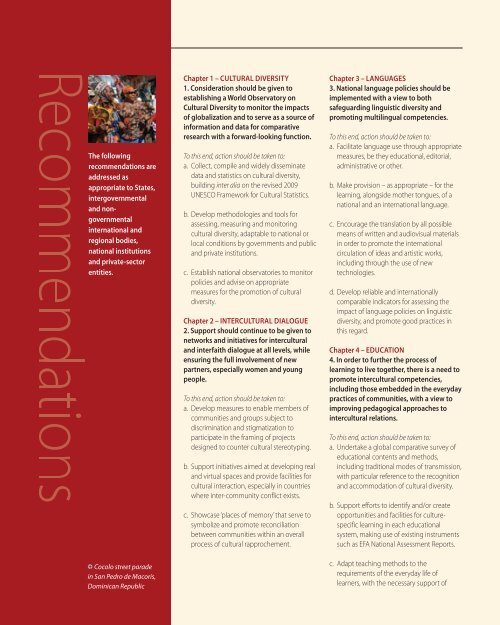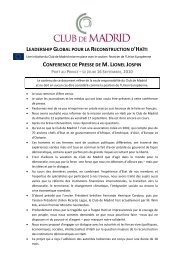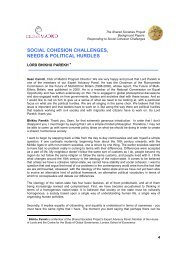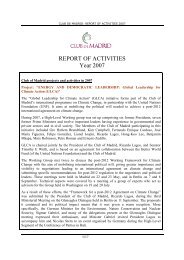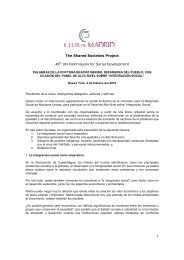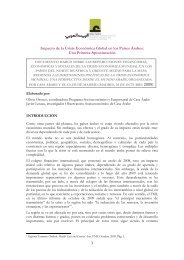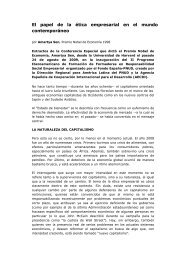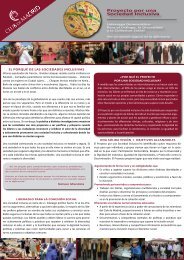Investing cultural diversity and intercultural dialogue - Business and ...
Investing cultural diversity and intercultural dialogue - Business and ...
Investing cultural diversity and intercultural dialogue - Business and ...
You also want an ePaper? Increase the reach of your titles
YUMPU automatically turns print PDFs into web optimized ePapers that Google loves.
34 . CULTURAL DIVERSITY<br />
The following<br />
recomm endations are<br />
addressed as<br />
appropriate to States,<br />
intergovernmental<br />
<strong>and</strong> nongovernmental<br />
international <strong>and</strong><br />
regional bodies,<br />
national institutions<br />
<strong>and</strong> private-sector<br />
entities.<br />
L Cocolo street parade<br />
in San Pedro de Macorís,<br />
Dominican Republic<br />
Chapter 1 – CULTURAL DIVERSITY<br />
1. Consideration should be given to<br />
establishing a World Observatory on<br />
Cultural Diversity to monitor the impacts<br />
of globalization <strong>and</strong> to serve as a source of<br />
information <strong>and</strong> data for comparative<br />
research with a forward-looking function.<br />
To this end, action should be taken to:<br />
a. Collect, compile <strong>and</strong> widely disseminate<br />
data <strong>and</strong> statistics on <strong>cultural</strong> <strong>diversity</strong>,<br />
building inter alia on the revised 2009<br />
UNESCO Framework for Cultural Statistics.<br />
b. Develop methodologies <strong>and</strong> tools for<br />
assessing, measuring <strong>and</strong> monitoring<br />
<strong>cultural</strong> <strong>diversity</strong>, adaptable to national or<br />
local conditions by governments <strong>and</strong> public<br />
<strong>and</strong> private institutions.<br />
c. Establish national observatories to monitor<br />
policies <strong>and</strong> advise on appropriate<br />
measures for the promotion of <strong>cultural</strong><br />
<strong>diversity</strong>.<br />
Chapter 2 – INTERCULTURAL DIALOGUE<br />
2. Support should continue to be given to<br />
networks <strong>and</strong> initiatives for inter<strong>cultural</strong><br />
<strong>and</strong> interfaith <strong>dialogue</strong> at all levels, while<br />
ensuring the full involvement of new<br />
partners, especially women <strong>and</strong> young<br />
people.<br />
To this end, action should be taken to:<br />
a. Develop measures to enable members of<br />
communities <strong>and</strong> groups subject to<br />
discrimination <strong>and</strong> stigmatization to<br />
participate in the framing of projects<br />
designed to counter <strong>cultural</strong> stereotyping.<br />
b. Support initiatives aimed at developing real<br />
<strong>and</strong> virtual spaces <strong>and</strong> provide facilities for<br />
<strong>cultural</strong> interaction, especially in countries<br />
where inter-community conflict exists.<br />
c. Showcase ‘places of memory’ that serve to<br />
symbolize <strong>and</strong> promote reconciliation<br />
between communities within an overall<br />
process of <strong>cultural</strong> rapprochement.<br />
Chapter 3 – LANGUAGES<br />
3. National language policies should be<br />
implemented with a view to both<br />
safeguarding linguistic <strong>diversity</strong> <strong>and</strong><br />
promoting multilingual competencies.<br />
To this end, action should be taken to:<br />
a. Facilitate language use through appropriate<br />
measures, be they educational, editorial,<br />
administrative or other.<br />
b. Make provision – as appropriate – for the<br />
learning, alongside mother tongues, of a<br />
national <strong>and</strong> an international language.<br />
c. Encourage the translation by all possible<br />
means of written <strong>and</strong> audiovisual materials<br />
in order to promote the international<br />
circulation of ideas <strong>and</strong> artistic works,<br />
including through the use of new<br />
technologies.<br />
d. Develop reliable <strong>and</strong> internationally<br />
comparable indicators for assessing the<br />
impact of language policies on linguistic<br />
<strong>diversity</strong>, <strong>and</strong> promote good practices in<br />
this regard.<br />
Chapter 4 – EDUCATION<br />
4. In order to further the process of<br />
learning to live together, there is a need to<br />
promote inter<strong>cultural</strong> competencies,<br />
including those embedded in the everyday<br />
practices of communities, with a view to<br />
improving pedagogical approaches to<br />
inter<strong>cultural</strong> relations.<br />
To this end, action should be taken to:<br />
a. Undertake a global comparative survey of<br />
educational contents <strong>and</strong> methods,<br />
including traditional modes of transmission,<br />
with particular reference to the recognition<br />
<strong>and</strong> accommodation of <strong>cultural</strong> <strong>diversity</strong>.<br />
b. Support efforts to identify <strong>and</strong>/or create<br />
opportunities <strong>and</strong> facilities for culturespecific<br />
learning in each educational<br />
system, making use of existing instruments<br />
such as EFA National Assessment Reports.<br />
c. Adapt teaching methods to the<br />
requirements of the everyday life of<br />
learners, with the necessary support of


